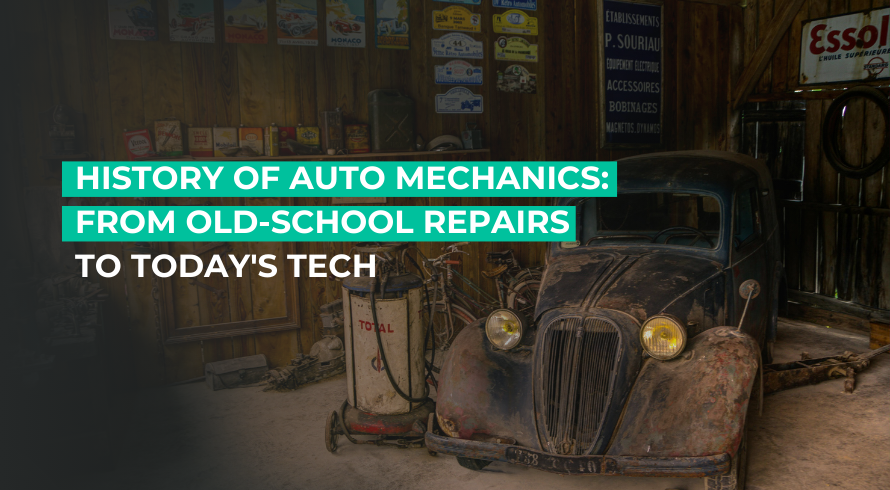Auto mechanics have been around since the time the first vehicle was around. In the very beginning, there were no fancy auto shops. The auto repair industry was backyard garages and dusty barns. Auto mechanics were blacksmiths and hobbyists.
But over the past 100 years, these blacksmiths and hobbysits have evolved into highly skilled technicians. They have evolved by acquiring skills, learning new tools, and getting trained. The most skilled are the ones who invest in learning and getting trained. Whether it is adapting to EV or calibrating ADAS sensors, those who keep up are the most successful mechanics.
Let’s map out the history of auto mechanics from the 1900s to 2025, and see how they have evolved with the changing times.
How auto mechanics started (1900s - 1930s)
When automobiles started replacing horses, there was a need for vehicle maintenance and repair. But fancy OBD II sensors, TPMS tools, and other technologies were not available. Blacksmiths, bicycle mechanics, or car mechanics themselves repaired these vehicles. They had some basic equipment and some basic knowledge about chains and gears, but no formal education. There was no training, they just worked with intuition and a few handy tools in dusty garages, sheds, barns, and service stations. Yes, no fancy auto shops loaded with equipment.
The most common repairs were tire and tube patching, carburetor adjustments, etc. The modern-day auto mechanics emerged with continuous training, learning, investments in tools, and a desire to improve, but back then, they
- Had no standardized parts, so mechanics needed a different set of tools, parts, and repair techniques for each vehicle.
- Didn’t have any formal training, which meant there was no standard quality of repair
- Relied on fabricating and modifying parts
- Adapted tools from blacksmithing or general machinery
So it all started with minimal knowledge, minimal tools, and equipment. Mechanics were just experimenting and figuring out what worked and what didn’t. But then came the post-war expansion and standardization. Things started to shift here.
Era of specialization and regulation (1940s-1980s)
After the war, there was increased car ownership. The middle class expanded and started spending on houses and vehicles. The vehicles were also more complex now. They weren’t as simple as before. For example,
- Imported vehicles were available now
- There were electronic components added such as radios, lights, and fans
- Manual clutch control moved to automatic transmissions
- Electric starters, wipers, and gauges for the heating system were added.
This also made repairs a lot more complex. They required specialization. The auto mechanics again rose to the challenge.
They now had to go from tire patching to understanding the charging systems and diagnosing electrical faults. Mechanics now can’t modify parts of the tools. They needed specialized tools to work on these complex vehicles. They now needed full knowledge of electrical troubleshooting because of all the electrical components of the vehicles. These complications meant they needed formal training and education.
Training and education
With so many rapid advancements, self-taught mechanics couldn’t keep up. The newer systems were complex. This led to trade schools and vocational programs offering automotive technician courses.
In 1972, the National Institute for Automotive Service Excellence (ASE) was established. This helped standardize mechanic qualifications. Even manufacturers started offering training sessions for dealership technicians so they could learn the brand-specific technologies.
Regulations
With advancements came regulations. So many vehicles on the road meant more pollution. In 1970 emissions regulations like the Clean Air Act set national standards for air quality and vehicle emissions. When this was set, manufacturers had to comply. It led to new technologies such as the catalytic converters. This again meant mechanics had to pivot and learn nw diagnostic skills.
Growth of the auto repair industry
As the auto industry grew with imported vehicles coming in, increased vehicle ownership, and rapid development of vehicles, it also led to the growth of independent shops. Formalized training of mechanics meant there were new business opportunities. The same backyard garages and sheds became professional auto repair shops. These shops also gave customers more options for service and repairs. The shops invested in processes, ensured better customer experience, and set up proper billing systems to remain competitive in the industry.
The tool truck culture also gained steam with the increase in the number of auto shops. This meant that tools came directly to the mechanic’s workspace. Companies like Snap-on and Matco brought high-end, specialized tools right to the mechanic. This allowed them to bypass retail stores and go to their customer.
The digital transformation
In the 90s, computers took over. Just like every other industry, the auto industry also completely transformed as a result. It was the era of digital diagnostics and computer-controlled vehicles.
Free Shop Handbook eBook
Discover the essential steps to create a compliant and effective Shop Handbook with our comprehensive eBook.
OBD II scanners
OBD I scanners were very basic and vehicle-specific. They only gave limited trouble codes, so it wasn’t of much help to mechanics. OBD II (On-Board Diagnostic) scanners were mandatory for all vehicles manufactured in 1996. This was the most defining moment of the modern auto repair industry. This came with a standardized port, universal trouble codes, and real time data access. This helped mechanics identify problems, get to the root cause and solve it quickly.
Scanning tools
A step up from the OBD II scanners were the bidirectional scan tools. These can communicate with the vehicle’s computers in two directions, not just read codes. This is helpful for technicians as it allows them to diagnose and check individual parts.
J2534 pass-thru device
The J2534 pass-thru programming device enables communication between a vehicle’s electronic control unit and diagnostic or reprogramming tools. This is great for independent repair shops and technicians as it helps them perform diagnostics on different vehicle brands. With this, they don’t need manufacturer-specific tools.
Independent repair shops and technicians can save on investment as they won’t have to spend on proprietary diagnostic equipment. This empowers them to work without a hefty upfront cost.
As a result…
All of these devices gave independent repair shops and technicians the power to fix vehicles and work on them. The Right to Repair movement came about as a response to manufacturers holding back access to parts, tools, repair guides, and diagnostic information. This movement gave legal rights to owners to fix their own vehicles and was a revolutionary step for technicians and independent shops.
Before the ‘Right to Repair’ movement, manufacturers said unauthorized repairs could damage the vehicle. When in reality, these repairs end up costing a lot more and hence promote the throw-away culture. Instead of repairing the vehicle, customers would send it to the junkyard.
Rise of shop management software
In this era of complex vehicles and even more complex repairs, shops relied on more tools to get work done so they could focus on repairs.
This is where shop management software emerged, which day-to-day shop management easier. Everything from communication with customers and vehicle inspections can be done digitally by mechanics. Solutions like AutoLeap have quickly become a handy, all-in-one management tool for shop owners and technicians. It helped them with digital vehicle inspections, digital estimates, invoicing, and faster and more transparent communication with customers. This also empowered them to grow their business.
How auto mechanics work today
In the past 25 years alone there have been major advancements in technology. Vehicles are far more complex and require advanced knowledge, training, and experience. Simply testing, experimenting and working on a ‘hunch’ won’t cut it. They need high-tech skills.
A few examples of what mechanics need to know.
- How ADAS calibration works. ADAS-equipped vehicles might need static or dynamic calibration or sometimes both. This depends on the ADAS system and the OEM requirements. All these will need different tools and equipment. Plus, auto mechanics will also need to know when ADAS calibration is even needed. This extensive knowledge to carry out ADAS calibration.
- Electric vehicles and hybrid vehicles, and how to service these. EVs and hybrid vehicles have a high-voltage systems. Although repairs might be simpler than other vehicles, auto mechanics need to know safety protocols, such as high-voltage (HV) training, personal protective equipment (PPE), and even battery isolation procedures.
- Telematics and OTA further complicate repair procedures. These allow vehicles to send and receive data. These software-defined vehicles require additional training and education so technicians can work with the latest vehicles.
These are just a few of the many advancements in the auto industry. This directly impacts how the auto mechanics work.
How has training and certification changed over time for auto mechanics
Early 1990s: Informal learning and apprenticeship
In the very beginning, the blacksmiths were self-taught. They were hobbyists, and they learnt through informal apprenticeships. It was all about experimentation, working and learning from experience. There were no formal training courses or opportunities.
1940s-1960s: Rise of vocational and trade schools
As vehicles became a little more complex, vocational training started. Trade schools opened up that allowed people to learn formally.
1972: ASE certification for mechanics
Then came the Automotive Service Excellence certification, which is a professional credential from the National Institute for Automotive Service Excellence. The certification credits the knowledge and skills of automotive professionals. This step helped establish a national standard of competency.
1980s onwards: OEM-led skill development and training
Manufacturer-specific training started around this time, which was important for dealership technicians. It gave them specific knowledge and training to work with vehicles of a certain manufacturer.
2010s to now: Modern diagnostics and vehicle technology
The auto industry is far more complex now. With the advent of EVs and hybrid vehicles, specialized certifications were needed to follow safety protocols. Technicians also require a specific understanding of ADAS calibrations. This meant higher standards of learning and a growing requirement for technicians to be certified.
What does a mechanics toolkit look like now
Just as the auto mechanics training and formal education have changed, so has the toolkit they work with. With advanced vehicles come advanced toolkits used to service and repair vehicles.
Back then, basic tools like wrench sets, hammers, dwell meters, timing lights, spark-plug-gap tools, pre-OBD II scanner tools, and distributor machines were used. The diagnosis was based on hunches, feel, and sound, as not much data was available. Tools weren’t as advanced, so they relied on experience.
Now, in addition to a few basic tools like wrenches and sockets, they also have bidirectional scan tools, J2534 programming devices, ADAS calibration targets, and high-voltage safety gear. They also have AI-driven diagnostic tools. The diagnosis today is based on data and predictive analysis. Nothing is a guesstimate. It is all rooted in proper information they gather with all these tools.
Wrapping up
Things have come a long way since the humble beginnings in the early 1900s. Over the past few decades, the advancements have accelerated. Vehicles became more complex, and the knowledge required to service and maintain them became complex too. It required specialized knowledge, training, formal education, and certifications. These certifications helped in upholding standards in the auto repair profession.
The mechanics’ history may have begun as blacksmiths, but they’ve now evolved into high-tech professionals with extensive knowledge of various advanced equipment and systems.
FAQs
When did auto mechanics first need formal training?
Auto mechanics first needed formal training between the 1930s and 1950s when there was a notable growth in the industry, such as the emergence of advanced vehicles and the need for specialization.
Why is 1996 a key year in the history of auto mechanics?
1996 is a key year for auto mechanics as OBD-II systems became compulsory for all new passenger cars.
What is the most important certification for a mechanic today?
The Automotive Service Excellence certification is the most important and highly recognized certification for mechanics today.
How did emissions regulations change the mechanic’s job?
Emissions regulations changed the mechanic’s job by moving from mechanical repairs to computer diagnostics that were needed to manage emissions control systems.
What does ADAS calibration require from a mechanic?
ADAS calibrations require specialized tools, OEM guidelines, and proper documentation of procedures.
How is EV service different for a mechanic?
In an electric vehicle, there is no internal combustion engine (ICE), so there is a high-voltage electric system. Mechanics need knowledge of software diagnostics, electrical systems, and other unique parts.








